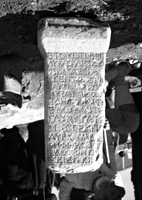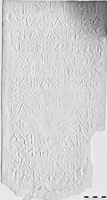 MAMA XI 144 (Pentapolis)
MAMA XI 144 (Pentapolis) 
Funerary bomos of Aur. Asklepiodora and family
- Type of monument:
- Funerary bomos.
- Location:
- Kilter (Çevrepinar) (Pentapolis): beside a fountain; said to have been brought from Yanıkören.
- Description:
- Bomos of grey-white marble, broken below, face slightly chipped to left and right.
- Dimensions:
- Ht. 0.58+; W. 0.28 (upper moulding), 0.22 (shaft); Th. 0.26 (upper moulding), 0.22 (shaft); letters 0.015-0.022.
- Record:
- Squeeze; line drawing; MB notebook copy; photograph (1955/88)
- Publication:
- Ramsay 1883: 405, no. 21; (Ramsay, Phrygia II 718, no. 652).
- Date:
- AD 260 (Year 345 of Sullan era, Month 3)
Ἔτους τμε´, μ(ηνὸς) γ´.
Αὐρ(ηλία) Ἀσκληπιοδ-
ώρα κατεσκεύ-
ασεν τὸ ἡρῷον̣
5[ἑ]αυτῇ καὶ τῷ γλυ̣-
κυτάτῳ μου ἀ̣-
νδρὶ Αὐρ(ηλίῳ) Γαΐῳ
Εὐτ⟨ύ⟩χου καὶ τῷ
γλυκυτάτῳ
10μου τέκνῳ
Αὐρ(ηλίῳ) Κουάρτ̣ῳ
μνήμης χάριν·
ε̣ἰ δ’ ἕτερ̣όν τις ἐπ-
ισενέγκει εἰ⟨ς⟩ τ-
15ὸ μν̣η̣μ̣ε̣ῖον, ἔ̣σ̣τε τῳ
πρὸς
[τὸν Θεόν. ]
Line 8: The mason originally inscribed ΕΥΧΟΥ through haplography, then inserted a small tau between the upsilon and chi.
Lines 11-15: R(amsay) was able to read considerably more of the inscription here.
Lines 13-14: ἐπ|ισενένκει R.
Year 345, Month 3. Aur(elia) Asklepiodora built the heröon for herself and for my sweetest husband Aur(elius) Gaius, son of Eutyches, and for my sweetest child Aur(elius) Quartus, in memoriam. If anyone inters another in the tomb, he shall have to reckon with [God].






The stone was copied by Ramsay at Kilter (today Çevrepinar) in 1883, ‘in a courtyard’; both Ramsay and Ballance were informed that the stone had been brought from Yanıkören (perhaps the ancient Lysias or Otrous: cf. MAMA XI 153 (1955/30)). The lower part of the stone had suffered damage between 1883 and 1955, but Ramsay’s restoration of the Eumeneian formula in lines 15-16 (MAMA XI 36 (1954/14)) is very likely to be correct. For the use of the Sullan era in the Pentapolis, see Leschhorn 1993: 268-70; for the use of numbered months in this region, see the commentary to MAMA XI 80 (1956/36: Sebaste). For the atonic personal pronoun τῳ (= αὐτῷ) in line 15, see Brixhe 1987: 80, and compare Ramsay, Phrygia II 525, no. 367 (Eumeneia).